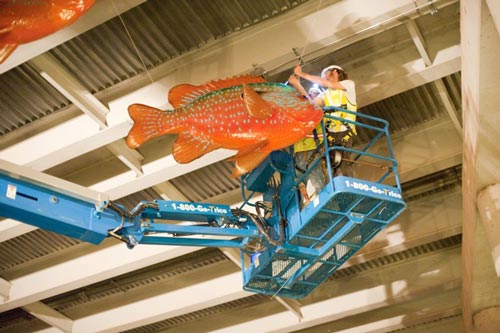 Paul Hinz |
Paul Hinz is marketing coordinator of Adaptalift, an Australian family-owned provider of forklifts, elevated work platforms, cleaning equipment, fleet management and telemetry systems.
Hiring the wrong EWP or having inexperienced operators can increase the risks associated with working at heights.
Here are four key considerations when making a decision on which EWP unit is best to hire for an application.
1. Are operators properly trained and licensed?To legally operate any access equipment in Australia, operators need to hold, as a minimum, a EWPA Yellow Card.
To operate boom lifts, operators are required to hold an HRW WP license.
EWPA yellow card and high risk work licenses are valid for a five-year period and can be renewed via the completion of a refresher course every five years.
 Operators must be familiar with how each individual EWP unit operates |
It is imperative that unit owners and operators are familiar with how each individual EWP unit operates including all safety features and unit capabilities, so they operate the unit in a safe way while avoiding common mistakes such as overloading, hitting objects or overturning the unit.
All operators must have a full understanding of the unit's emergency shutdown procedures so they can respond promptly in case of emergency, thus limiting the potential for harm or damage to people and property.
2. Scissor or boom lift - Which type of EWP do you need?Scissor and boom lifts are the most common types of EWP units available for hire.
Scissor lifts are work platforms that can only move vertically, with no ability to telescope or rotate (like a boom lift).
The scissor lift's unique rising mechanism is achieved through the linking of folding supports in a criss-cross X pattern.
Scissor lifts are commonly used in the construction industry for applications such as applying cladding, repairing lights or building maintenance as they are able to safely accommodate an operator's tools in the platform while they are raised.
Boom lifts are elevating work platforms that can be either telescoping, hinged or articulated devices or a combination of any of the aforementioned, which supports a platform or basket for personnel and materials to be elevated to work.
The advantage of using a boom lift over a scissor lift is its ability to articulate around obstructions and reach areas at an angle.
Is the unit operating inside, outside or both?Vertical man-up lifts are legally only allowed to operate indoors, while scissor and boom lifts can be operated both indoors and outdoors.
Strict operational height guidelines set out by both manufacturers and safety organisations detail how high a unit's platform can be safely raised based on a combination of the number of occupants, the load weight and operational conditions.
Safe raised height for units will vary depending on the operational area. Generally, when operating outdoors, specified safe loads are smaller than when operating indoors due to the impact which weather conditions, such as high winds, can have in destabilising the unit and its platform.
4. Is the operating area smooth, flat or uneven?The surface the EWP is planned to operate on is a key consideration when deciding which type of EWP to hire.
With small wheels, electric scissor lifts can safely operate on flat and smooth surfaces most commonly found indoors.
Larger diesel scissor and boom lifts have large tyres and oscillating axles and can be operated across the rough and uneven terrain of outdoor environments.
An often-overlooked access issue is the surface units must be driven or moved across from the machine delivery and pick-up point to where it will be working.